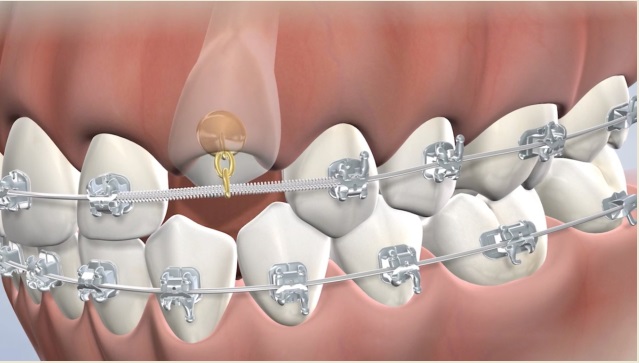I am 17 and still have my upper left baby canine teeth. My dentist took an X-ray in February and said the baby canine should fall out soon. Nothing has changed, so I’m wondering if I should be concerned. Also, is there some type of tooth replacement I can get until the tooth erupts? I just want to fill the gap. Thanks. Konnor from MA
Konnor,
Permanent canine teeth usually erupt between the ages of 10 and 12. If they haven’t appeared by age 14, it is concerning. Canine teeth can become impacted, requiring intervention to erupt. Addressing the problem early increases the chances of guiding the tooth into proper alignment.
Delaying treatment can result in the tooth fusing to the bone. Once this happens, the tooth can no longer be moved and must be extracted. For both dental health and social reasons, waiting until 16 or 17 is far from ideal.
How to Determine Why a Canine Tooth Won’t Erupt
A dentist or orthodontist can use a panoramic X-ray to determine whether the root of the unerupted canine is fully formed. Extracting the baby canine at the right time can help the permanent tooth emerge, especially if it’s close to the surface.
If the baby canine is already loose, that’s an encouraging sign—the permanent tooth may be near the surface and erupt on its own. If the baby tooth isn’t loose, the X-ray will help judge how close the adult tooth is and whether it needs help erupting.
Given your concerns about the current dentist, it’s reasonable to get a second opinion from an orthodontist to determine the status of the canine tooth.
What to Expect with Guided Tooth Eruption
If guided tooth eruption is needed, the procedure is not overly complex. Here’s how it works:
- A minor surgical procedure exposes the crown of the impacted canine. Then:
- A bracket is bonded directly to the crown of the tooth.
- A small chain is attached to the bracket.
- The chain connects to a spring or wire.
- As the tooth moves downward, the chain is shortened gradually.
This process continues until the tooth is fully in position. The entire process usually takes about a year.
Why Avoid a Replacement Tooth Where One Hasn’t Erupted?
Avoid placing a replacement tooth in the area at this stage. It could block the permanent canine from erupting properly, complicating treatment.
Plano, Texas, female dentist Dr. Miranda Lacy sponsors this post.
